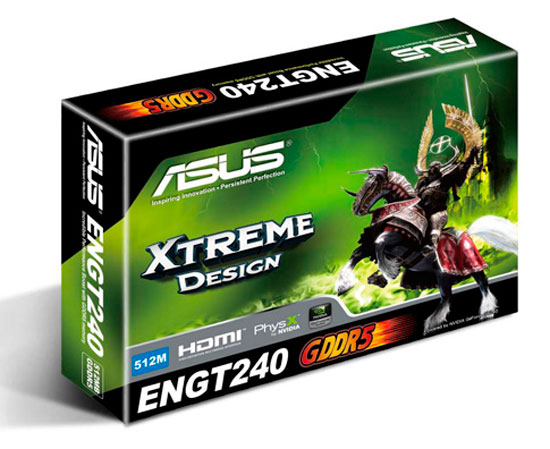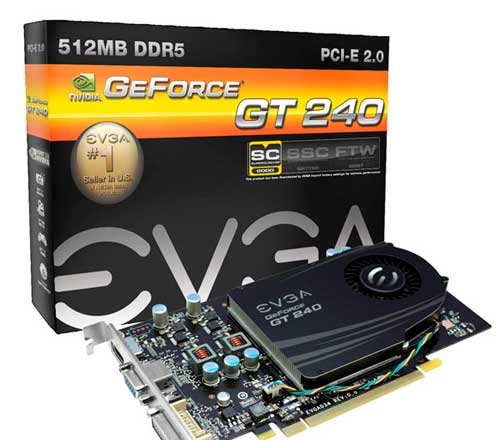NVIDIA’s GeForce GT 240: The Card That Doesn't Matter
by Ryan Smith on January 6, 2010 12:00 AM EST- Posted in
- GPUs
Late last year NVIDIA launched the 2nd of their 40nm parts, the GT 240. Based upon the GT215 core, the GT 240 is functionally a derivative of the low-end GT 220. Compared to the GT 220 it packs twice as many shader units, twice as many texture units, and support for GDDR5, making it a good deal faster than the GT 220. As a GT 220 derivative, this also means it comes with DirectX 10.1 support and the VP4 video decode engine.
| Form Factor | 9800 GT |
GT 240 (GDDR5)
|
GT 240 (DDR3) | 9600GT | GT 220 (GDDR3) |
| Stream Processors | 112 | 96 | 96 | 64 | 48 |
| Texture Address / Filtering | 56/56 | 32/32 | 32/32 | 32 / 32 | 16 / 16 |
| ROPs | 16 | 8 | 8 | 16 | 8 |
| Core Clock | 600MHz | 550MHz | 550MHz | 650MHz | 625MHz |
| Shader Clock | 1450MHz | 1340MHz | 1340MHz | 1625MHz | 1360MHz |
| Memory Clock | 1800MHz | 3400MHz | 1580MHz | 1800MHz | 1800MHz |
| Memory Bus Width | 256-bit | 128-bit | 128-bit | 256-bit | 128-bit |
| Frame Buffer | 512MB/1GB | 512MB | 512MB/1GB | 512MB | 512MB |
| Transistor Count | 754M | 727M | 727M | 505M | 486M |
| Manufacturing Process | TSMC 55nm | TSMC 40nm | TSMC 40nm | TSMC 55nm | TSMC 40nm |
| Price Point | $89-$119 | $99 | $89-$99 | $69-$85 | $69-$79 |
NVIDIA’s latest efforts at lowering idle power usage can be seen here, with a 9W idle power usage (only 2W more than the GT 220) while load power is specified as 70W – 70W likely being chosen to avoid the need for a PCIe power connector. The transistor cost of these extra functional units means that the GT 240 comes in at an estimated 727M transistors, occupying a die area we measure at 144mm2.
Unfortunately, not everything got the same boost as compared to the GT 220. Specifically the number of ROPs remains the same at 8, and worse yet the core clock speed is only 550MHz on the GT 240, versus 625MHz (or more) on the GT 220. So not only did the GT 240 not get more rasterizing power to go with its other enhanced abilities, but in fact it’s ever-so-slightly slower than the GT 220 when it comes to rasterizing. For the sake of comparison this is also half as many ROPs as on the 9600GT and 9800GT, both of which are also clocked higher.

As is often the case with lower-end products, the GT 240 is actually composed of two specifications. There is a DDR3 based GT 240, and a GDDR5 based GT 240. The former has 25.44GB/sec of memory bandwidth, while the latter has 54.4GB/sec. This results in 3 cards: An $89 GT 240 with 512MB of DDR3, a $99 GT 240 with 1GB of DDR3, and a $99 GT 240 with 512MB of GDDR5.
Officially, NVIDIA says the following about the GT 240: “The GeForce GT 240 sits between the GeForce GT 220 and GeForce 9800 GT in price and performance.” In essence this is intended to be a significantly faster GT 220, a solid card whose only crime was price.
In theory this is a great position for the card, but reality bites, hard. For starters we have the stratification of the cards based on memory bandwidth. A DDR3 GT 240 is not comparable to a GDDR5 GT 240 in most cases, and you’ll understand why when you see our benchmarks. The memory bandwidth starvation when using DDR3 means that the DDR3 GT 240 is often in its own lesser performance class, a problem when most DDR3 GT 240s are equipped with 1GB of the stuff and sell for as much as their GDDR5 brethren.
The other problem is that while the GT 240 is supposed to be below the 9800GT in price, it’s not. It’s certainly below it in performance, but one can easily find just as many sub-$100 9800GTs as one can GDDR5 GT 240s, including a number from higher-tier manufacturers. For all practical purposes the 512MB 9800GT and the 512MB GDDR5 GT 240 come in at the same price, which as we’ll see makes it very hard to justify the GT 240 when you can get a faster card for the same price.
Finally, there’s the matter to discuss of actually reviewing a card. NVIDIA and their partners are well aware of the problems in positioning the GT 240, so it shouldn’t come as a surprise that no one really wants to talk about these cards. As was the case with the GT 220, NVIDIA did not send out sample cards for the press for review. Even NVIDIA’s vendors are squeamish about the matter, as none of them could get us a card before the launch - one even dropped out after initially offering a card upon realizing that a negative review would be forthcoming.
We can’t really blame NVIDIA or their partners for not wanting to volunteer a card they know would get a poor review, but if you have ever wondered why you don’t see launch-day reviews of these cards like you do more reasonably priced cards, this is why. To that extent we thank eVGA and Asus for sending us GT 240 cards in spite of the poor positioning of the GT 240 line.
With that out of the way, let’s look at today’s cards.












55 Comments
View All Comments
samspqr - Wednesday, January 6, 2010 - link
the cards are in shops already, firmly in 9800gt territory, and nearly 20% more expensive than 9600gt... but at these prices it means you're just paying a $10 premium in order to have the newer card; ati's replacement of 4870/4850 with 5770/5750 meant a much bigger premium for new-but-equally-performing tech (you had bigger power savings there, though)and, of course, I missed some comparisons with ATI cards in the conclusion, something to the tune of: "in any case, it is just sad that nvidia is unable to manufacture new chips to compete with anything ati has, other than a 4670"
nafhan - Wednesday, January 6, 2010 - link
The reason ATI can have a big premium on the 57XX (and 58XX) is that they've got no competition. The 57XX series in particular has PLENTY of room to drop in price as it's a much simpler card to build than the 4850/70 cards that it is replacing. Nvidia has similar performance for a similar price, but it's based on older tech with higher power consumption. The prices will probably stick until Nvidia comes out with a real challenger for the 5 series (i.e. Fermi).Spoelie - Wednesday, January 6, 2010 - link
Why is the GT240 only compared to nvidia cards in the entire review (except for the benchmark images)? It would be to the benefit of the reader to also know how it compares to ATi in the value for money area. What is the current price of say a 4670/4770/4850 in 512MB/1GB configurations and how would that compare in terms of value?Also, with such a small impact, I think the evga card should have been left out of the factory-clock benchmark graphs for future lookup convenience & easy relative comparison. The performance difference compared to the normal card could have been summarized on a dedicated page.
pugster - Wednesday, January 6, 2010 - link
http://www.newegg.com/Product/Product.aspx?Item=N8...">http://www.newegg.com/Product/Product.a...=AFC-Ben...Saw on newegg that you can get this 240gt with 1gb ddr3 memory for $58 after rebate.
plague911 - Wednesday, January 6, 2010 - link
I think the over all point was that you may as well not even consider the GT240. If you wanted a generic ATI/NVIDIA comparison you would use a different nvidia card. Not to say that nvidia may not beat ATI in a comparison but a different nvidia would be a better choice for the comparisonRyan Smith - Wednesday, January 6, 2010 - link
The 4800 and 4700 series have effectively been discontinued, the remaining cards are fairly rare and usually overpriced. There's little to gain comparing the GT 240 to a 4770 or 4850, as you can no longer get ahold of those cards for reasonable prices most of the time.That leaves the 4670, which the GT 240 beats.
hydrocarbon - Wednesday, January 6, 2010 - link
I can grab a 1GB 4850 off NewEgg now for a hundred and ten bucks, or a 512MB for a hundred. "Rare", sure, but "overpriced"? They're cheaper now than they've ever been, especially if you consider those are prices w/o rebates.MadMan007 - Wednesday, January 6, 2010 - link
Just FYI there is such a thing as the used video card market ;) while you can't compare pricing yourself and include it in the written details a savvy user who is looking at used cards will be able to do so.Taft12 - Wednesday, January 6, 2010 - link
Yes, but bear in mind the lack of warranty (XFX double lifetime notwithstanding) and unknown overclocking/stress history. These things make used video card purchases a non-starter.Taft12 - Wednesday, January 6, 2010 - link
... a non-starter IMHO of course